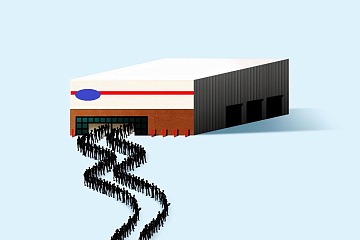When employers take the time to check in on staff during times of disruption, it ensures employee trust is not broken.
They say timing is everything, and any leader who has ever had to manage people during layoffs, mergers, or other company changes would undoubtedly agree.
It’s an obstacle we’ve heard from many leaders, including Great Place To Work® Certified™ workplaces. These are companies that fully appreciate the importance of the employee experience, but even they worry sometimes that the timing isn’t right when it comes to seeking employee feedback.
Now is always a good time
Does the statement below sound familiar?
“We just had layoffs/leadership changes/a merger, so things need to settle first.”
It’s understandable. After all, administering an employee engagement survey right after a series of layoffs probably isn’t a good move, right?
Actually, it is.
While things like mergers and layoffs bring big changes to the workplace, they also bring big opportunities. Our research into common HR challenges has shown that when leaders take the time to foster trusting relationships, employees embrace change better.
If a disruptive event has created a culture of uncertainty in your workplace, building trust during this time is one of the smartest strategies you can implement. It signals to employees that their experience is a high priority to you. Even if you anticipate the results may be impacted by recent events, you still want to know what your people are experiencing.
5 tips for overcoming bad timing
If you’re in the midst of a major disruptive event, you can help restore calm and dismantle fear by leaning into the vulnerability, rather than suppressing it for the sake of “saving face.”
Here are five tactics to use if your workplace is undergoing change.
1. Communicate with and check in on employees
Even if you don’t have all the answers, acknowledging people’s fears and offering continued assurance that you will tell them what you can, as soon as you can, is a trust-building activity.
Managers often have to deliver the message of layoffs, budget cuts, and restructures. Rather than sugarcoating, which dismisses employees’ feelings and impedes trust, the best leaders:
- Are authentic, honest, and forthright about what has to be done
- Promote that everyone is facing change together
- Supply employees with all information available and outline next steps
- Use adversity as a catalyst to bond and work together to develop solutions
- Offer a sense of safety and support
2. Involve employees as much as possible
When real estate investment company Camden Property Trust underwent a reorganization in 2022, it did the opposite of what many companies do in the face of layoffs: It chose to confront the elephant in the room.
Immediately after the restructuring, Camden set up working groups to provide feedback on what was and wasn’t working. Not all the feedback was good. But through that honesty, the company was able to empower employees and give them a voice.
Reengaging employees after a difficult time builds trust. And when employees trust that management is doing everything it can to avoid another layoff, employees are:
- 9x more likely to give extra effort
- 2x more likely to adapt quickly to business changes
- 4x more likely to stay with the company
3. Consider all solutions and possibilities
When stress levels are already sky-high, it’s easy to turn to whatever solution is the quickest and easiest to implement.
But it’s important to take your time and address changes with careful thought — even if that means overhauling how your team works in the new setup.
Global digital entertainment provider Vrio had to address this after a restructuring of its territories into new regions and reporting lines. Diego Benavides, country managing director at DIRECTV Peru, said that optimizing the new structure took several months of discussions with focus groups to analyze the challenges facing them.
Rejecting the traditional top-down approach, the team has since been able to churn out new product designs and solve issues with cross-departmental collaboration.
4. Honor the results of change
While all change is difficult at first, good change should bring forward new and improved ways of working. Look for opportunities to pause, seek feedback, and bring employees together to reflect or honor the results of that change. At Camden, participants in the working group said they valued the chance to help shape the company’s future.
5. Focus on strengths and build from there
Examine what your people do best and how those advantages can be applied to the new circumstances. When you focus on strengths, it enables everyone to find their footing faster and manage change with less fear and more trust in their company, co-workers, and abilities.
While transitioning to remote work during the pandemic, ALKU leaned into its biggest strength — their deeply ingrained recognition culture — to ensure a high level of employee trust and appreciation, maintaining its company values, even in unprecedented circumstances.
Despite a drastic change from a 100% office-based work environment to a fully remote setup, 99% of employees reported feeling appreciated in their employee survey.
ALKU achieved this through new remote-friendly recognition strategies such as the weekly “Corporate Cup Program,” which highlights outstanding efforts of individuals or groups.
These initiatives, tuned to the work-from-home scenario, not only helped in retaining the essence of their vibrant work culture but showcased ALKU’s commitment to employee well-being, thereby forging a stronger bond of trust and camaraderie amidst challenging times.
In times of disruption, stay consistent
A final note: Don’t let change undo the employee trust you’ve cultivated to date, such as diversity initiatives (often the first to fall away during layoffs) or commitments to transparency (often absent during M&As). To better position your team for success in the new setup, double down on clear communication and show employees that you care.
When software companies Kronos and Ultimate Software merged to create UKG, one of employees’ primary concerns was benefit retention. In response, the leadership team recalibrated benefits across both companies, which resulted in an even more generous package.
This was a change that wouldn’t have happened without input from employees — something that UKG requested to ensure the merger went as smoothly as possible for everyone.
Get our latest research
Download our white paper on the most common obstacles HR professionals face when creating a thriving company culture.













